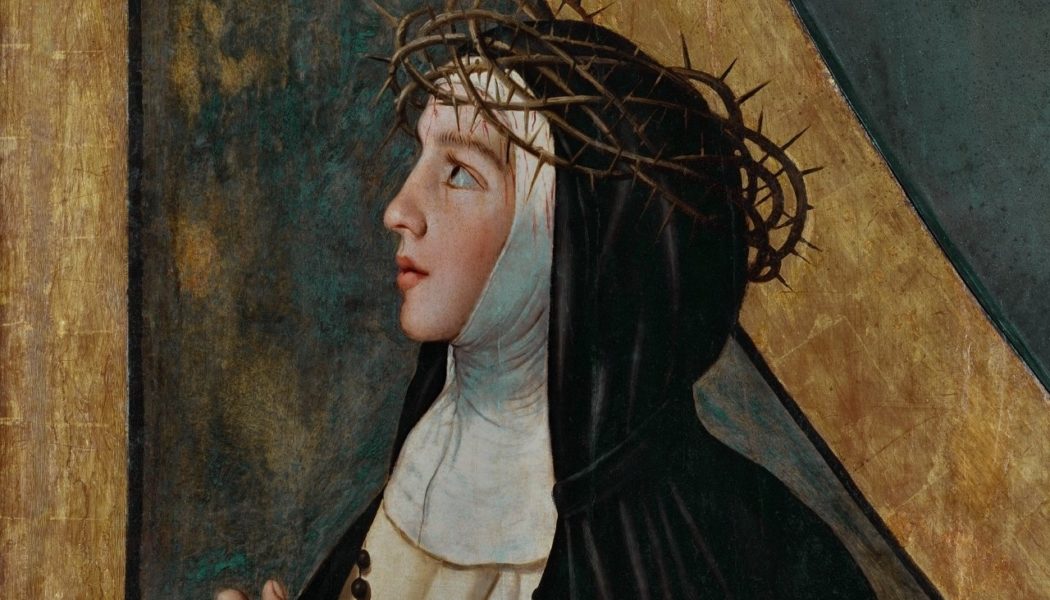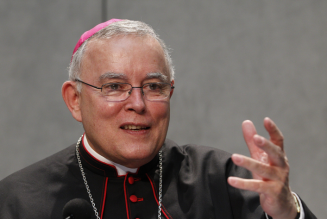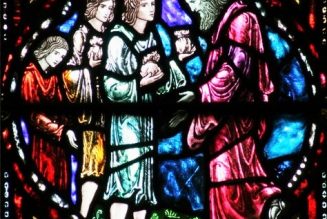
Born on the Feast of the Annunciation in 1347, Saint Catherine of Siena died at the age of thirty-three—the same age as her Savior at his death. She lived during a time of widespread disease, despair, and debauchery, yet, when the young Catherine Benincasa looked for answers as to why such suffering was occurring in the world, she pointed to an unlikely source: herself.
Disease, Despair, & Debauchery
During Catherine’s lifetime, the Black Death ravaged Europe; the more conservative estimates conclude that one-quarter of Europe’s population died from the plague. Others estimate that closer to half of Europe’s population died from the pestilence—and awfully fast. Though historians disagree about the overall number of casualties, they agree that the plague could kill its victims within hours or even minutes.
It was said that during this time, living persons envied the dead. Many people thought that succumbing to the horror of the plague was not a matter of if, but when. With the horror of inevitability dancing in their heads, some chose not wait long enough for the plague to bring their death, but chose instead to bring their own death by suicide.
Others tried to work in as much physical pleasure as they could before the presumed-inevitable plague overcame them. Wanton drunkenness and sexual immorality were embraced. After the most significant outbreak of the plague, people celebrated with more drunkenness. Giovanni Boccaccio (1313-1375) lived in Florence during this time and wrote that many people,
“…believed that drinking excessively…satisfying in every way the appetites as best one could…was the best medicine for such a disease; so they practiced to the fullest what they believed by going from one tavern to another all day and night, drinking to excess…doing everything that pleased or amused them the most. This they were able to do easily, for everyone felt he was doomed to die…” —Giovanni Boccaccio
Boccaccio’s Decameron also evidences that the only sin that was more widespread than drunkenness was sexual immorality. There was a frantic impetus for a man to “sin today, for he would certainly die tomorrow.”
The Response of the Church
What was the response of the Church to all this? There were certainly heroic priests that traveled to administer the sacraments, but others refused to come. If a Catholic were dying, his chances of receiving Anointing of the Sick were low: first, he had to find a priest who was willing to administer the sacraments; second, he had to stay alive long enough for the priest to arrive.
During this time, the human leadership of the Catholic Church was largely AWOL, especially at the top. Seven consecutive popes chose to literally abandon Rome for roughly seventy years and take up residence in France (often known to history as the “Avignon Papacy”). It was only in the final years of Catherine’s life that she witnessed a pope actually reside in Rome, and when Pope Gregory XI finally did return and passed away, the Western Schism followed.
Laying Blame
If a woman looked for places to cast blame, she would run out of fingers long before she could point at all the guilty parties. To be sure, Catherine—saint, stigmatist, and future doctor of the Church—was not afraid to criticize the actions of others: even the pope, even publicly, even with scathing rebukes. But she did so in a way that was painstakingly charitable—in a way that challenged others to recognize their great value as unique persons loved by God.
Still, Catherine Benincasa blamed much of the misery and sadness in the world on her own sins.
Was this simply a case of naiveite on Catherine’s part? By blaming her own sins, did Catherine simply fail to understand what was really going on the world? Even a casual study of her life and writings quickly dispels that notion. Catherine knew about the evils and tribulations of her day with a deeper, profoundly more spiritual, and more eschatological insight than any of those around her. But she also had an insight into the nature of sin—and the frightful damage that her own sins caused.
What About Me?
In our fallen nature, we are eager to blame others for the world’s troubles. It’s them. They are at fault. Their sins are terrible. Good thing I’m not like him or her. But as Catherine reminds me, it is my fault—at least in larger measure than I’d like to admit.
There is a basic moral maxim: Do good and avoid evil. But an honest autobiography of my half century on this earth would necessarily include lengthy chapters illustrating my inversion of that maxim.
God asked me to love Him with my entire heart, soul, mind, and strength, but it’s often been a fractional love—if that. I have failed to love my neighbor more times than I could count. I turned a deaf ear to those who needed me to listen; I turned a blind eye toward those who needed me to see. I left many words of encouragement unspoken, while words of discouragement loquaciously flowed from my lips. There were many times when a situation called for fortitude, but I answered with fear instead. And when it came time to simply speak up for the valiant, I chose silence. So many times I could have prayed for the world generally or loved ones specifically, but I deemed something else more important.
How have the sum of my sins affected the world? Mercifully, I’ll never know—at least in this life. But I do know this: Each and every one of my personal sins has caused suffering in the world. That was Catherine’s point. So, before we blame “others” or “society,” we might do well to ponder that.
A Note of Hope
We are so busy lamenting the “state of the world” that we forget: the state of the world begins with the state of my soul.
Still, there is a note of great hope to all this. Because if my sins can have a butterfly effect, then so can my good works. It is vital that we remember this. We have sinned, but our good acts can help heal us and help heal those around us.
While it is true that my sins have caused suffering, it is also true that my good works have caused happiness and joy. And so have yours. A kind word, a smile, a hug, a prayer, a word of encouragement, a work of corporal or spiritual mercy—only in Heaven could we possibly comprehend the magnitude of these good acts in our pasts. After all, there are no “little” acts of kindness, for kindness is magnificent by its very nature.
What is exciting is that today offers us a chance for more good acts, for more works of kindness, for more hope, for more healing. Regardless of each and every sin in our past, today offers us a staggering and wonderful opportunity for faith and hope and charity—to flap our wings and better the world. Even a world in turmoil.
Especially a world in turmoil.
Cover Image: Juan Bautista Mayno, Public domain, via Wikimedia Commons
Join Our Telegram Group : Salvation & Prosperity








